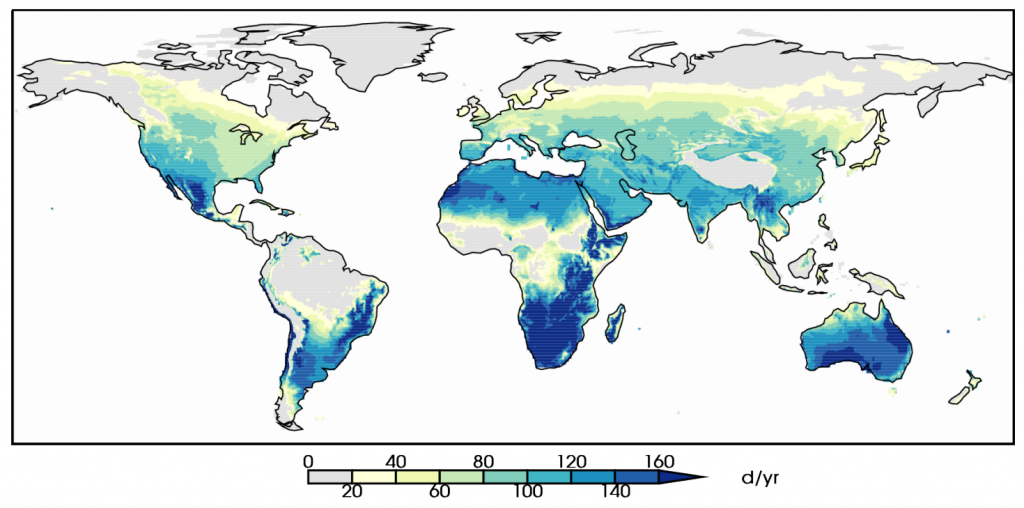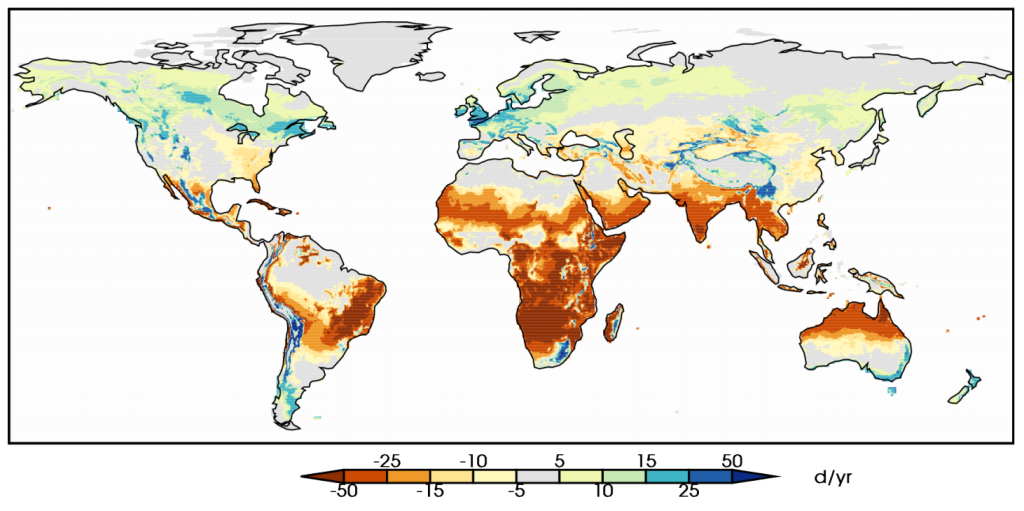
Dramatic decrease in ‘mild’ weather for tropical countries by 2100
Robert McSweeney
01.18.17Robert McSweeney
18.01.2017 | 5:15amWhile climate change tends to be associated with extreme weather events or the long-term rise in global average temperature, a new study takes a different angle by considering what could happen to ‘mild’ weather conditions.
The research, published in Climatic Change, find that warm, dry days that are ideal for outdoor activities, construction work and travel could change dramatically by the end of the century.
While temperate countries such as the UK and US could see more mild days in future, tropical countries could see a decline of more than 50 days in the average year. This means more hot and humid days for the tropics, the researchers say, with fewer mild days to break up summer heatwaves.
But it’s important that that prospect of more mild weather in the northern hemisphere doesn’t distract from tackling climate change, other scientists tell Carbon Brief, as more severe extreme rainfall and heatwaves will also increase as the climate warms.
Mild weather
Outside of the UK, where the weather is a constant preoccupation, a spate of mild weather might not make it onto the front pages of the newspapers. But it’s still an important part of our day-to-day lives, says lead author Dr Karin van der Wiel, a postdoctoral research scientist at Princeton University and the Geophysical Fluid Dynamics Laboratory of the US National Oceanic and Atmospheric Administration. She tells Carbon Brief:
“[Mild weather] does not cause societal problems in the way extreme conditions do, but people enjoy mild weather and build activities around it. For an individual person it may therefore be very important.”
Largely overlooked in climate research, the new study attempts to fill the gap by creating a metric for “mild” weather and working out which countries could get less and which could get more.
Determining what counts as mild weather is tricky, says van der Wiel, as what a person thinks of as “mild” depends on where they live, the time of year and past experience. So van der Wiel and her colleagues created a relatively simple metric that they could apply across the world. She explains:
“To be counted as a mild day, the maximum temperature has to be between 18-30C, no more than 1mm of rain and a dew point [temperature] of less than 20C (a measure of humidity).”
The map below shows how mild days are distributed across the world at the moment. The regions with dark blue shading have the most mild days each year, while the grey areas have none at all. Overall, there is currently a global average of around 74 days of mild weather per year.

Average annual number of days with mild weather in the present climate (1986-2005). The darker the shading, the more mild days per year. Source: van der Wiel (2017).
In general, mild weather in tropical areas is hindered by being very wet and humid, the study says. Temperate regions tend to be limited by temperature – with winters in particular being too cold to be classified as mild. The map suggests that subtropical regions, such as South Africa and Australia, have the highest number of mild days. For example, Cape Town and Sydney get an average of 197 and 144 mild days per year, respectively.
Contrasting results
![]()
Using a collection of climate models, the researchers estimated how mild weather across the world could change by the end of the century. They use a moderate scenario of future climate change called RCP4.5.
You can see their findings in the map below. Areas shaded orange or brown are expected to see a fall in the number of mild days, while those in green and blue are likely to see an increase.

Projected change in average annual number of days with mild weather, from 1986-2005 to 2081-2100. Brown and orange shading shows expected drop in days of mild weather, while greens and blues show increases. Source: van der Wiel (2017).
Overall, the findings suggest the world will see an average of 10 fewer mild days by the end of the century. But regional changes are much larger, the study says.
Rising temperatures are projected to bring more days of mild weather in temperate countries such as the UK, US and Canada. For example, London could get an extra 24 mild days a year by the end of the century, while Los Angeles might get an extra six.
In contrast, hotter and more humid conditions will see decreases of over 50 mild days per year in large parts of tropical Africa, Asia and South America. Van der Wiel explains:
“In these regions summers may become increasingly hostile; there will be fewer mild days to break up long heat waves, for example. The regions losing mild weather are very similar to regions being negatively impacted by climate change in economic terms.”
Lima in Peru is projected to lose 114 mild days in the average year, the researchers say, while Dakar in Senegal and Mumbai in India could see 57 and 44 fewer mild days per year, respectively.
As the results are under a moderate emissions scenario, the changes would be larger and occur earlier this century if emissions aren’t curbed, she adds.
Climate change mitigation
While the tropics will be most affected by changing mild weather, it’s the increases for temperate countries that troubles Dr Patrick Egan, associate professor of politics and public policy at New York University, who co-authored a similar study about recent increases in “pleasant” weather in the US. He tells Carbon Brief:
“Emissions reductions in these places are crucial to the mitigation of climate change. But this study indicates we cannot rely on shifts in daily weather to mobilise the public in the northern hemisphere to demand a policy response.”
Although an increase in mild weather might sound desirable, it will come with other aspects of climate change too, notes van der Wiel:
“Those include changes in mild weather, but also changes in mean climate, changes in extreme conditions and even remote changes that may impact society via indirect ways. A good place to live is determined by much more than mild weather alone.”
Prof Richard Allan, professor of climate science from the University of Reading, who also wasn’t involved in the study, agrees. He tells Carbon Brief:
“Even over regions such as the UK, which are expected to see an increase in mild conditions, the science tells us that the intensity of extreme rainfall and heatwave events will increase with continued warming related to greenhouse gas emissions.”
It’s also worth bearing mind that the study’s definition of “mild” is very broad, adds Allan:
“[The study] does not consider factors such as the strength of the sun or wind, nor how one person’s ‘mild’ may be another’s ‘scorchio’.”
This means there’s plenty of work to be done to refine this analysis for specific regions and countries, says van der Wiel:
“We hope future studies will look more into the mild weather problem and more complicated criteria may be researched. One possibility to extend the current study is to have location dependent criteria, to match expected climatic differences between, for example, the UK and the Mediterranean area.”
Van der Wiel, K., et al. (2017) Shifting patterns of mild weather in response to projected radiative forcing, Climatic Change, doi:10.1007/s10584-016-1885-9

